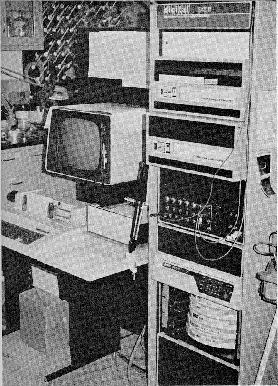Early Computing
Environment
 Here
is a picture of the "Pharmacology Graphics System" in its incarnation as
a Digital Equipment Corporation (DEC) PDP 11/34. (It began its life as
a PDP 11/10 with a full complement of 56 kilobytes!) At the left
is the dot matrix printer, the vector-drawing graphics display with "light
pen", and, on the shelf next to the tractor feed of the printer, a pen
plotter (a one-color-at-a-time precursor to the ink jet). On the right
are two dual disk drives, each containing one permanent and one removable
"RK05" platter (only about a megabyte or two capacity per platter!), the
analog-to-digital and digital-to-analog converter patch panel (for data
acquisition and control), the central processor, and a storage bay for
removable RK05 platters.
Here
is a picture of the "Pharmacology Graphics System" in its incarnation as
a Digital Equipment Corporation (DEC) PDP 11/34. (It began its life as
a PDP 11/10 with a full complement of 56 kilobytes!) At the left
is the dot matrix printer, the vector-drawing graphics display with "light
pen", and, on the shelf next to the tractor feed of the printer, a pen
plotter (a one-color-at-a-time precursor to the ink jet). On the right
are two dual disk drives, each containing one permanent and one removable
"RK05" platter (only about a megabyte or two capacity per platter!), the
analog-to-digital and digital-to-analog converter patch panel (for data
acquisition and control), the central processor, and a storage bay for
removable RK05 platters.
Vector-drawing displays move their electron beam in an arbitrary path called a display list. The refresh rate is a function of the length of the display list, so the display starts to flicker badly if the display list becomes too complex. The "light pen" reports the X and Y coordinates of the electron beam as it passes by the photodiode at the tip of the light pen. Instead of moving a cursor with a mouse and clicking mouse buttons, you drag a "target" around the screen and point at options listed on the screen with the light pen.
Early incarnations of the system ran DEC's RT-11 real-time operating system. Custom applications were written BASIC and Fortran IV. Later incarnations ran small flavors of BSD UNIX. We wrote UNIX device drivers for the graphics display and the A/D and D/A converter and ported the custom applications to C.